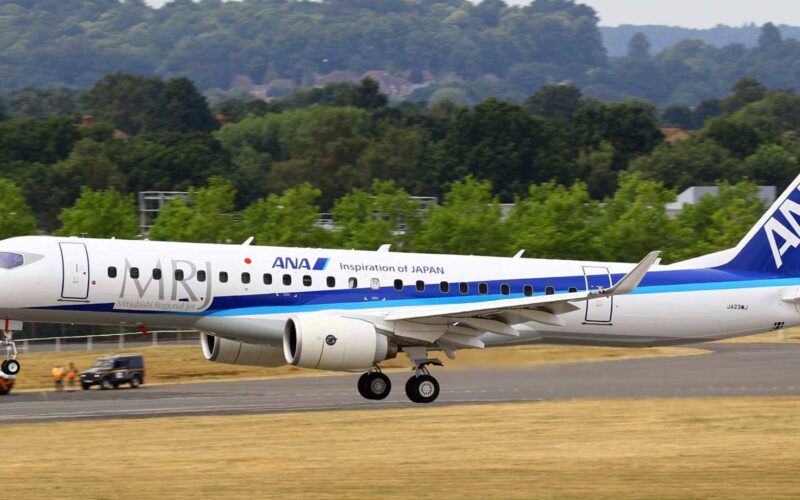The Aircraft That Will Revolutionize Regional Air Travel
FlightGlobal predicts that the regional jet market will be worth more than $120 billion in the coming 20 years. Around 40% of that value comes from aircraft which can fit 70 to 76 people per flight, serving the North American market. Based on this, it naturally has attracted the big players of aerospace manufacturing – Airbus and Boeing have invested heavily in Bombardier and, pending approval, Embraer respectively.
And currently, Bombardier and Embraer are the biggest regional jet manufacturers. But as their fleets age, someone saw a window of opportunity to take a slice of the cake. That someone is Mitsubishi – a corporation that is probably known to the general public as a company which builds cars, air conditioners and various machine tools. But outside of that, Mitsubishi is also involved in building ships, missiles, automotive components and most importantly for us, aircraft. If you have not flown on a Mitsubishi plane, don’t be surprised, as it is mostly involved in building military aircraft.
But that is about to change.
Mitsubishi announced the MRJ, a regional jet set to take over the world.
Window Of Opportunity
As mentioned above, the regional jet market is going to get bigger and bigger by the year. To reap in the profits of it, Mitsubishi showcased the first MRJ (an acronym for Mitsubishi Regional Jet) prototype in the 47th Paris Air Show in 2007. The Mitsubishi MRJ is the first commercial passenger jet built and designed in Japan since 1962 when NAMC started producing the YS-11. The concept shown at Paris was a full-scale mock-up of the MRJ Cabin, with a 1/20th scale model of the aircraft itself. The first outing was very promising – it was the first regional jet that had an all-composite airframe and airlines were impressed by its top of the line efficiency.
A few months later Mitsubishi opened up the order books for airlines. Mitsubishi set the test flights to begin in 2011, certification in 2012 and to introduce them in 2013. The first orders came in and over the years Mitsubishi MRJ has secured 213 firm orders and 194 committed options.
However, over the same years, the company has struggled to deliver on its promises. Just to illustrate, Mitsubishi is promising to deliver the first Mitsubishi MRJ aircraft in 2020. As I declared earlier, the primary plan was to deliver the jet in 2013. That’s quite a difference.
Because of this, the whole ordeal has suffered massively. Some orders were canceled and it was very difficult to convince airlines to purchase the aircraft. But has the window of opportunity closed?
Promises Of An Angel
But before we jump the gun and get into the details of the current MRJ situation, we need to understand as to why the Mitsubishi MRJ has gathered so much hype. Mitsubishi promised an excellent set of specifications of the MRJ – lowering emissions, having less fuel consumption than its competitors and industry leading comfort for passengers.
I do understand that sounds very abstract and basically, every manufacturer promises that, so to illustrate let’s dig deeper into the numbers.
Pratt & Whitney specifically designed the engines for the MRJ. The new engine requires 30% fewer turbine airfoils, meaning less maintenance time and cost. A completely new engine gear system with the sleek fuselage design has allowed the Mitsubishi MRJ to use 20% less fuel than its competitors. The same design features reduced noise and emissions pollution by 40%. The widest and highest cabin in the regional jet class assures the maximum comfort for passengers.
Mitsubishi has vowed to deliver a jet that would take over the world. Well, at least some regions of it.
On the other hand, it had many major issues. As a result, many delays have followed.
Issues Delayed Your Mitsubishi MRJ Flight
The first batch of delays came in 2009. Mitsubishi changed the materials used in the wings from carbon fiber composites to aluminum. Mitsubishi acknowledged that this was a huge change to the whole concept, and delayed the project by half a year.
However, this was only the beginning. In 2012 Mitsubishi announced more delays are to come to optimize the production processes. Then only more problems came, as both Pratt & Whitney and then Mitsubishi encountered issues. After seeing a glimmer of hope, the maiden flight took off on November 11th, 2015. But then the companies, which ordered the MRJ, heard the bad news – Mitsubishi delayed the MRJ again. Due to the weak wings and the redesign of the landing gear.
The final delay came at the beginning of 2017. AeroTEC discovered problems with avionic systems and the wiring looms. Damage would cause a failure, thus disabling the aircraft completely. But this period finally marked the start to a stable point in the story of the MRJ. Successful testing flight hours are proving to customers that the MRJ is going to finally succeed.
Another proving point was the appointment of Alex Bellamy. Alex reorganized the whole MRJ programme structure and as a consequence, the MRJ has started to gain the ground it had lost during the delay debacle.
But is it too late for the regional jet?
Shifting Winds
In 2017 and 2018 the regional jet market underwent a very drastic change. Bombardier has been facing financial struggles for quite some time. Airbus saw a chance – they did not produce any regional jets, so it purchased a majority stake at Bombardier. That is when the Bombardier CSeries regional jets became the Airbus A220 and with the financial backing of a huge corporation, the now joint venture of Bombardier and Airbus A220 is predicted to take up around 60% of the regional jet market.
Not to fall behind, Boeing made its own move. In the summer of 2018, Boeing and the Brazilian Embraer announced a joint venture to take on Airbus-Bombardier endeavor. Experts regard this move as an even bigger shift – Embraer is currently the third largest aircraft manufacturer in the world.
What does that mean for the Mitsubishi MRJ? The market just got a lot more competitive. While its main competitors were struggling and Mitsubishi knew that there is no point in trying to compete with Airbus and Boeing. However, those 2 aviation giants just came through the door without knocking into the regional jet market.
And while the first batch of delays might have not impacted the potential success, this was a huge hit to the struggling, but improving programme of the Mitsubishi MRJ. Since there were potential clients who either decided not to order the jet or cancel their orders amass the delays. Eastern Airlines is a prominent example – the airline canceled the order, which took up 10% of the order book for the regional jets.
Is The MRJ Finished?
Although Mitsubishi finally managed to sort out the problems that have plagued the MRJ, there is still an elephant in the room.
The MRJ90, the larger Mitsubishi MRJ version is too heavy for its biggest order backlog. The MRJ70, which is going to be introduced a year later than the MRJ90 is too small. The two regional US airlines that ordered more than 70% of the total order count for the MRJ, are bound by scope clauses. To sum up scope clauses, its a contract between airlines and the pilot unions.
With the program costing Mitsubishi over $5 billion and the issues surrounding the orders, the whole ride seems like a roller coaster that goes up and down. Whenever there‘s a light at the end of a tunnel, there‘s a glass door that seems to block the path towards the light. The MRJ reminds me of the Lockheed L-1011 story, where the delivery of the aircraft was just too late.
Anyhow, I would really love the MRJ to take off. Even though it missed a brilliant opportunity to get ahead of the Airbus A220 and Embraer E2, the Mitsubishi MRJ still looks like it can revolutionize the regional jet market. And hopefully it does – competition only pushes everyone forward!









